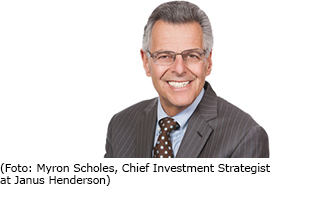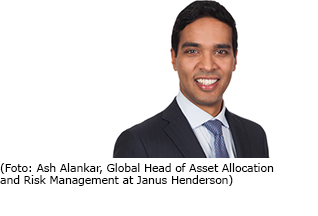
Janus Henderson: What investors can teach central banks about inflation
Myron Scholes is Chief Investment Strategist and Ash Alankar is Global Head of Asset Allocation and Risk Management at Janus Henderson. They say focusing on the threat from rising prices is no longer an imperative for the US Federal Reserve (Fed) and European Central Bank (ECB).
09.11.2017 | 09:48 Uhr
 Investors aren’t expecting a sharp uptick in inflation anytime soon. That is the message from the options market, where gold is out of favour, there’s no preference for inflation-protected Treasuries over nominal bonds and little excitement about consumer staples, which typically do well as price pressures mount.
Investors aren’t expecting a sharp uptick in inflation anytime soon. That is the message from the options market, where gold is out of favour, there’s no preference for inflation-protected Treasuries over nominal bonds and little excitement about consumer staples, which typically do well as price pressures mount.

At the same time, options are signalling low e
xpectations that global equities will experience either a sharp correction or much upside in the coming months. In other words, the world’s economic barometer is set fair according to options prices, which provide extremely efficient estimates of the market’s assessment of short-term risk.
Given central bankers are accused of being “behind the curve” by not acting swiftly enough to drain liquidity, US Fed chair Janet Yellen is due credit for proactively removing monetary stimulus and arguably getting ahead of the curve with four rate increases since December 2015. As a result, the Fed now has the luxury of being able to drain liquidity gradually, and in so doing avoid the danger of stifling growth along with equities, as happens when monetary stimulus contracts abruptly.
All of which is consistent with option prices signalling little risk for an upside shock to inflation or a downside jolt to equities. The muted risk to equities has been helped by the divergent ways in which the Fed and ECB plan to end their ultra-accommodative monetary policies.
Fed dot plots point to a rate hike in December and another three in 2018. At the same time, the US central bank will ease into an almost glacial tapering of reinvestment of the US$4.5tn of assets on its balance sheet. By contrast, the ECB will begin to taper its €60bn monthly asset purchase programme next year and is not expected to begin raising rates until sometime after 2018.
If this planned sequential approach can be achieved without other interventions spoiling the plan, markets will avoid being sucker-punched by a global liquidity crunch caused as the ECB and the Fed scale back stimulus.
And at such a pivotal moment, some continuity among central bankers might be beneficial. While Mario Draghi has another two years to implement his policies as president of the ECB, Donald Trump is expected to name Jerome Powell to succeed Ms Yellen when her term expires in February. A Fed governor since 2012, Powell’s thinking aligns closely with Yellen’s, suggesting he won’t seek a sharp change in the Fed’s course. Should a new Fed chair tighten too quickly or step back from normalisation, uncertainty may spike.
Just as importantly, the next Fed chief may find that the benign outlook for inflation is more than just a blip. The Fed has missed its 2% target for most of the past five years, while eurozone inflation is even more tepid. It’s largely because innovation and disruption have driven down costs globally, and that is a trend that is likely to continue.
Historic inflation targets are looking increasingly arbitrary in an age where structural changes are significantly altering how goods are supplied and consumed. Technological advances lift competition and productivity, putting downward pressure on prices. Automation by large companies will allow many countries to begin to repatriate jobs as the cost-of-production gap to countries such as China and Mexico narrows. Scarcity can become a vague concept in a world where technology can intermediate supply issues via substitution or creation.
While disinflation caused by a drop in demand is harmful, lower prices created by innovation and disruption are to be welcomed for the improvements they bring to choice, quality, capital allocation and demand.
For the Fed and ECB, inflation containment is no longer an imperative. Nor should it be in today’s fast-changing world where the natural inflation rate is very uncertain. Rather, central bankers should focus on strategically draining unprecedented liquidity in an orderly fashion, while keeping growth on track.
This article first appeared in the Financial Times on 1 November 2017:
https://www.ft.com/content/f266da56-bedc-11e7-9836-b25f8adaa111
Republished here with permission.



Diesen Beitrag teilen: